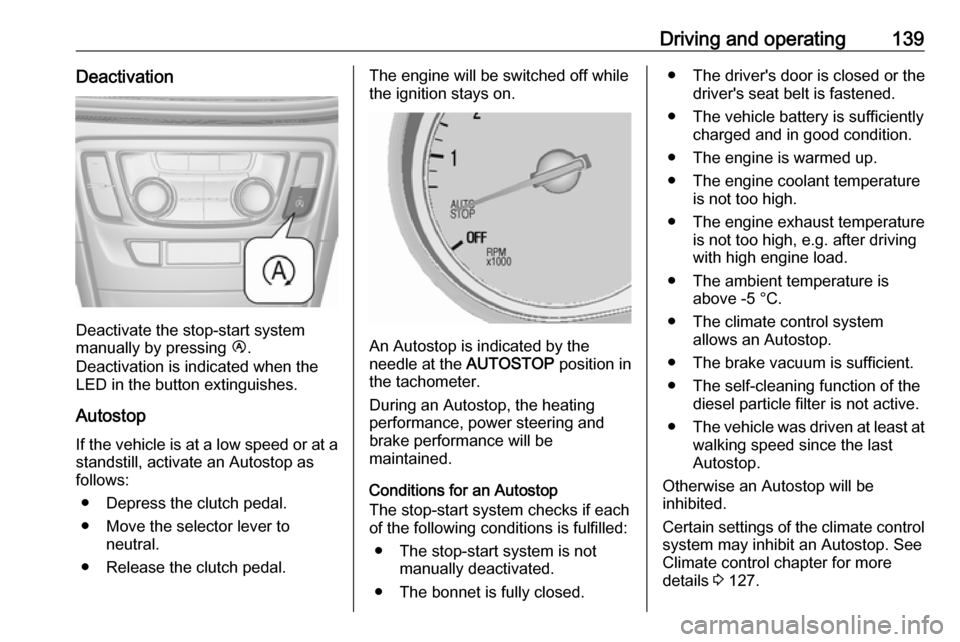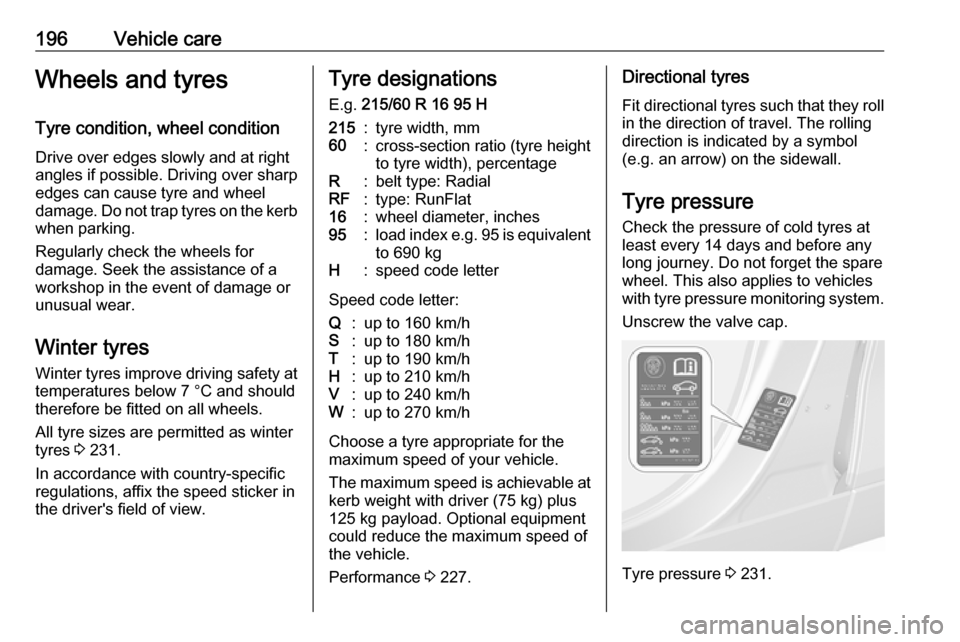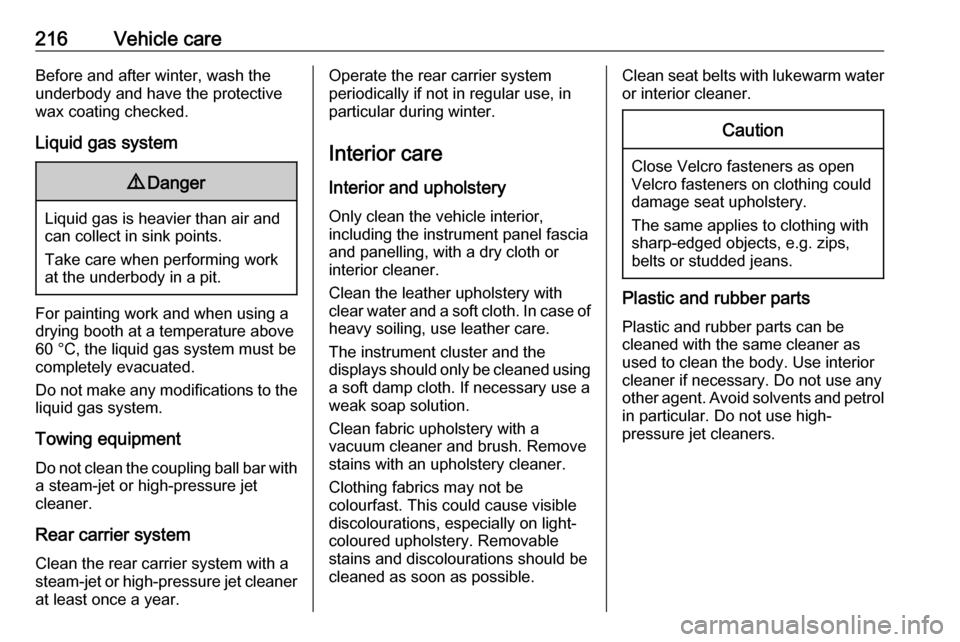belt OPEL MOKKA X 2017 Manual user
[x] Cancel search | Manufacturer: OPEL, Model Year: 2017, Model line: MOKKA X, Model: OPEL MOKKA X 2017Pages: 247, PDF Size: 6.59 MB
Page 115 of 247

Instruments and controls113Note
The vehicle location always remains
accessible to OnStar in the case of
an emergency.
Find the privacy policy in your
account.
Software updates
OnStar may remotely carry out
software updates without further
notice or consent. These updates are
to enhance or maintain safety and
security or the operation of the
vehicle.
These updates may concern privacy
issues. Find the privacy policy in your account.
ERA GLONASS
ERA GLONASS is a manually or
automatically actuated emergency
service. Emergency centres provide
assistance and information during an
emergency.
In case of an accident with activation
of airbags or belt tensioners, an
emergency call is placed
automatically. An immediateconnection with an advisor will be
established who will check whether
help is needed.9 Danger
The service is only available for
markets where it is legally required and activated. Furthermore, the
manual and the automatic
emergency call function depend
on the availability of the
emergency centres and the
infrastructure in the country.
Note
In order to be available and
operational, the system requires
functioning vehicle electrics, mobile
service and GLONASS satellite link.
Depending on equipment, a backup
battery is used.
Control buttons
SOS button K
Press K and after a prompt press
again to establish an emergency
connection.
TECT button J
Press J for cancellation of a call or for
service (technician use only).
Status LED
The system provides feedback via
voice messages and an LED.
Page 134 of 247

132Climate controlAir conditioning regularoperation
In order to ensure continuously
efficient performance, cooling must
be operated for a few minutes once a
month, irrespective of the weather
and time of year. Operation with
cooling is not possible when the
outside temperature is too low.
Service For optimal cooling performance, it is recommended to annually check the
climate control system, starting
three years after initial vehicle
registration, including:
● functionality and pressure test
● heating functionality
● leakage check
● check of drive belts
● cleaning of condenser and evaporator drainage
● performance check
Note
Refrigerant R-134a contains
fluorinated greenhouse gases.
Page 141 of 247

Driving and operating139Deactivation
Deactivate the stop-start system
manually by pressing Ï.
Deactivation is indicated when the
LED in the button extinguishes.
Autostop If the vehicle is at a low speed or at a
standstill, activate an Autostop as
follows:
● Depress the clutch pedal.
● Move the selector lever to neutral.
● Release the clutch pedal.
The engine will be switched off while
the ignition stays on.
An Autostop is indicated by the
needle at the AUTOSTOP position in
the tachometer.
During an Autostop, the heating
performance, power steering and
brake performance will be
maintained.
Conditions for an Autostop
The stop-start system checks if each
of the following conditions is fulfilled:
● The stop-start system is not manually deactivated.
● The bonnet is fully closed.
● The driver's door is closed or the driver's seat belt is fastened.
● The vehicle battery is sufficiently charged and in good condition.
● The engine is warmed up.
● The engine coolant temperature is not too high.
● The engine exhaust temperature is not too high, e.g. after driving
with high engine load.
● The ambient temperature is above -5 °C.
● The climate control system allows an Autostop.
● The brake vacuum is sufficient.
● The self-cleaning function of the diesel particle filter is not active.
● The vehicle was driven at least at
walking speed since the last
Autostop.
Otherwise an Autostop will be
inhibited.
Certain settings of the climate control
system may inhibit an Autostop. See
Climate control chapter for more
details 3 127.
Page 142 of 247

140Driving and operatingImmediately after motorway driving
an Autostop may be inhibited.
New vehicle running-in 3 134.
Vehicle battery discharge protection
To ensure reliable engine restarts,
several battery discharge protection
features are implemented as part of
the stop-start system.
Power saving measures
During an Autostop, several electrical
features such as auxiliary electric
heater or rear window heating are
disabled or switched into a power
saving mode. The fan speed of the
climate control system is reduced to
save power.
Restart of the engine by the driver
Depress the clutch pedal to restart the
engine.
The engine start is indicated by the
needle at the idle speed position in
the tachometer.
If the selector lever is shifted out of
neutral before depressing the clutch
first, - with a message is shown in
the Driver Information Centre.Restart of the engine by the stop-
start system
The selector lever must be in neutral
to enable an automatic restart.
If one of the following conditions
occurs during an Autostop, the
engine will be restarted automatically by the stop-start system:
● The stop-start system is manually deactivated.
● The bonnet is opened.
● The driver's seat belt is unfastened and the driver's door
is opened.
● The engine temperature is too low.
● The charging level of the vehicle battery is below a defined level.
● The brake vacuum is not sufficient.
● The vehicle is driven at least at walking speed.
● The climate control system requests an engine start.
● The air conditioning is manually switched on.If the bonnet is not fully closed, a
warning message is displayed in the
Driver Information Centre.
If an electrical accessory, e.g. a
portable CD player, is connected to
the power outlet, a brief power drop
during engine restart might be
noticeable.
Parking9 Warning
● Do not park the vehicle on an
easily ignitable surface. The
high temperature of the
exhaust system could ignite the
surface.
● Always apply the parking brake. Activate the parking
brake without pressing the
release button. Apply as firmly
as possible on a downhill slope
or uphill slope. Depress brake
pedal at the same time to
reduce operating force.
● Switch off the engine.
Page 198 of 247

196Vehicle careWheels and tyres
Tyre condition, wheel condition Drive over edges slowly and at right
angles if possible. Driving over sharp
edges can cause tyre and wheel
damage. Do not trap tyres on the kerb when parking.
Regularly check the wheels for
damage. Seek the assistance of a
workshop in the event of damage or
unusual wear.
Winter tyres
Winter tyres improve driving safety at temperatures below 7 °C and shouldtherefore be fitted on all wheels.
All tyre sizes are permitted as winter
tyres 3 231.
In accordance with country-specific
regulations, affix the speed sticker in
the driver's field of view.Tyre designations
E.g. 215/60 R 16 95 H215:tyre width, mm60:cross-section ratio (tyre height
to tyre width), percentageR:belt type: RadialRF:type: RunFlat16:wheel diameter, inches95:load index e.g. 95 is equivalent
to 690 kgH:speed code letter
Speed code letter:
Q:up to 160 km/hS:up to 180 km/hT:up to 190 km/hH:up to 210 km/hV:up to 240 km/hW:up to 270 km/h
Choose a tyre appropriate for the
maximum speed of your vehicle.
The maximum speed is achievable at kerb weight with driver (75 kg) plus
125 kg payload. Optional equipment
could reduce the maximum speed of
the vehicle.
Performance 3 227.
Directional tyres
Fit directional tyres such that they roll in the direction of travel. The rolling
direction is indicated by a symbol
(e.g. an arrow) on the sidewall.
Tyre pressure
Check the pressure of cold tyres at
least every 14 days and before any
long journey. Do not forget the spare
wheel. This also applies to vehicles
with tyre pressure monitoring system.
Unscrew the valve cap.
Tyre pressure 3 231.
Page 218 of 247

216Vehicle careBefore and after winter, wash the
underbody and have the protective
wax coating checked.
Liquid gas system9 Danger
Liquid gas is heavier than air and
can collect in sink points.
Take care when performing work
at the underbody in a pit.
For painting work and when using a
drying booth at a temperature above
60 °C, the liquid gas system must be
completely evacuated.
Do not make any modifications to the
liquid gas system.
Towing equipment
Do not clean the coupling ball bar with a steam-jet or high-pressure jet
cleaner.
Rear carrier system Clean the rear carrier system with a
steam-jet or high-pressure jet cleaner
at least once a year.
Operate the rear carrier system
periodically if not in regular use, in
particular during winter.
Interior care
Interior and upholstery Only clean the vehicle interior,
including the instrument panel fascia
and panelling, with a dry cloth or
interior cleaner.
Clean the leather upholstery with
clear water and a soft cloth. In case of
heavy soiling, use leather care.
The instrument cluster and the
displays should only be cleaned using
a soft damp cloth. If necessary use a
weak soap solution.
Clean fabric upholstery with a
vacuum cleaner and brush. Remove
stains with an upholstery cleaner.
Clothing fabrics may not be
colourfast. This could cause visible
discolourations, especially on light- coloured upholstery. Removable
stains and discolourations should be
cleaned as soon as possible.Clean seat belts with lukewarm water or interior cleaner.Caution
Close Velcro fasteners as open
Velcro fasteners on clothing could damage seat upholstery.
The same applies to clothing with
sharp-edged objects, e.g. zips, belts or studded jeans.
Plastic and rubber parts
Plastic and rubber parts can be
cleaned with the same cleaner as
used to clean the body. Use interior
cleaner if necessary. Do not use any
other agent. Avoid solvents and petrol in particular. Do not use high-
pressure jet cleaners.
Page 242 of 247

240IndexAAccessories and vehicle modifications .......................... 177
Adaptive forward lighting .....96, 119
Adjustable air vents ...................131
Airbag and belt tensioners ...........92
Airbag deactivation ................52, 93
Airbag label................................... 47 Airbag system .............................. 47
Air conditioning regular operation ................................ 132
Air conditioning system .............. 127
Air intake .................................... 131
Air vents...................................... 131
All-wheel drive ........................... 147
Antilock brake system ................ 148
Antilock brake system (ABS) .......93
Anti-theft alarm system ................30
Anti-theft locking system .............. 30
Appearance care ........................214
Automatic anti-dazzle ..................34
Automatic light control ...............116
Automatic locking ........................28
Automatic transmission .............143
Autostop ..................................... 138
Auxiliary heater ........................... 130
B Battery discharge protection ......125
Battery voltage ........................... 104Bicycle rack .................................. 61
Bonnet ....................................... 179
Brake and clutch fluid .................218
Brake and clutch system .............93
Brake assist ............................... 149
Brake fluid .................................. 182
Brakes ............................... 148, 182
Breakdown.................................. 212
Bulb replacement ....................... 186
C
Capacities .................................. 230
Catalytic converter .....................142
Central locking system ................24
Centre console storage ...............61
Changing tyre and wheel size ...202
Charging system .......................... 93
Child locks ................................... 29
Child restraint installation locations ................................... 54
Child restraints.............................. 53
Child restraint systems ................53
Climate control ............................. 16
Climate control systems .............126
Clock............................................. 81
Code ........................................... 103
Collision damage repair ..............235
Control indicators.......................... 87
Control of the vehicle .................134
Controls ........................................ 77
Page 245 of 247

243Rear view camera ...................... 160
Rear window wiper/washer .......... 80
Recommended fluids and lubricants ........................ 218, 222
Refuelling ................................... 169 Registered trademarks ...............237
Retained power off .....................136
Reversing lights .........................122
Ride control systems ..................149
Roof .............................................. 37
Roof load ...................................... 74
Roof rack ..................................... 74
S Seat adjustment ....................... 6, 41Seat belt ........................................ 8
Seat belt reminder .......................92
Seat belts ..................................... 44
Seat heating ................................. 43
Seat position ................................ 40
Selector lever ............................. 143
Service ....................................... 132
Service display ............................ 87
Service information ....................217
Side airbag system ......................50
Software acknowledgement .......235
Spare wheel ............................... 208
Speed limiter......................... 96, 154
Speedometer ............................... 84
Starting and operating ................134Starting off ................................... 17
Starting the engine ....................137
Steering ...................................... 134
Steering wheel adjustment ......9, 77
Steering wheel controls ...............77
Stop-start system........................ 138
Storage compartments .................59
Sunglasses storage .....................60
Sunroof ........................................ 37
Sunvisor lights ........................... 124
Sun visors .................................... 36
Symbols ......................................... 4
T
Tachometer ................................. 85
Tail lights ................................... 188
Three-point seat belt .................... 45
Tools .......................................... 195
Top-tether fastening eyes ............58
Tow bar....................................... 173
Towing ................................ 173, 212
Towing another vehicle .............213
Towing equipment .....................174
Towing the vehicle .....................212
Traction Control system ............. 149
Traction Control system off........... 94
Traffic sign assistant .............97, 161
Trailer towing ............................. 173
Transmission ............................... 17
Transmission display .................143Tread depth ............................... 201
Trip odometer .............................. 84
Turn and lane-change signals ...122
Turn signal ................................... 91
Tyre chains ................................ 202
Tyre designations ......................196
Tyre pressure ............................ 196
Tyre pressure monitoring system ............................... 95, 197
Tyre pressures ........................... 231
Tyre repair kit ............................. 203
U
Ultrasonic parking assist............. 158
Underseat storage .......................61
Upholstery .................................. 216
Uplevel display ............................. 97
Using this manual ..........................3
V Valet mode ................................. 101
Vehicle battery ........................... 183
Vehicle checks............................ 179
Vehicle data ................................ 222
Vehicle data recording and privacy ..................................... 237
Vehicle detected ahead ................96
Vehicle dimensions .................... 229
Vehicle Identification Number ....220
Vehicle jack ................................ 195
Vehicle messages .....................103